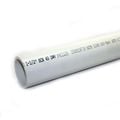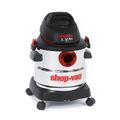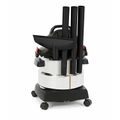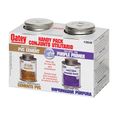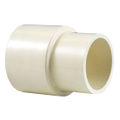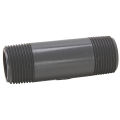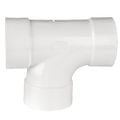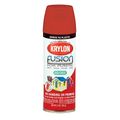(→Costs) |
|||
| Line 102: | Line 102: | ||
|-class="sortbottom" | |-class="sortbottom" | ||
|colspan="4" align="right" | '''Total Cost''' | |colspan="4" align="right" | '''Total Cost''' | ||
|align="right"| '''$. | |align="right"| '''$102.11''' | ||
|} | |} | ||
Revision as of 22:46, 1 May 2016
Abstract

The purpose of this project is to develop a demonstration device that displays the principles of how objects move in a vacuum. The idea is to build a Vacuum Bazooka that will shut a ball into the air due to the difference in pressures between the outside and the inside of the Bazooka. Ultimately our goal for the vacuum demonstration device is to provide an entertaining hands on demonstration yet also provide an educational experience to the students and staff of Zane Middle School.
Background
The spring 2016 Engineering 215 design class from Humboldt State University was working together with Zane Middle School from Eureka. The purpose of this association was to give the opportunity to students from the Design class an opportunity to learn the basics of working in teams and also to get experience in real life projects. J.AT.O the name of this team was in charge of developing a demonstration of how objects move in a vacuum chamber and its effects in ordinary objects. By developing this projects, J.A.T.O team will be able to show Zane students a quick view to the science world at the same tame the will be having fun.
Problem statement and criteria
Zane Middle School is in need of a demonstrational instrument that will display the properties of a vacuum to students. The criteria of this project were safety, time constraints, cost, material availability, and overall effectiveness of solution.
Description of final project
The final project is a fully operational vacuum bazooka. The vacuum bazooka is capable of shooting cylindrical projectiles that fill the volume of the PVC pipe. The cylindrical projectiles must fill the volume of the PVC pipe as this increases the suction force created from the vacuum, which in turn launches the projectile further. In order to make our vacuum we utilize a Shop-Vac 5986000 5-Gallon that has a peak of 4.5 HP. The shop vacuum is attached to a tee connector that is attached to the barrel. The length of our PVC pipe which composes our barrel is 5 ft.
Costs
Testing Results
This section will be improved upon after completion of the vacuum bazooka. The "Testing Results" section will include a discussion of how the vacuum bazooka performs after it has been initially constructed. This will include a speed analysis of the projectile that is fired to determine if it's potentially too fast or unsafe for a demonstration. Information on how the vacuum bazooka performs during the demonstration for the students at Zane Middle School will also be included.
How to build
| Step | Description |
|---|---|
| 1 | Cut the PVC pipe so it is 5ft in length. |
| 2 | Apply PVC Glue Primer (purple can) to the inside of one end of the 'T' bracket. |
| 3 | After 1 minute of letting the Primer set, add the Glue (gold can) directly over the primer and twist the 'T' bracket onto the PVC pipe. |
| 4 | Clean off the excess glue and wait 15 minutes for glue to set. |
| 5 | Apply Glue Primer to the inside of the wide end of the CM Hose Adapter. |
| 6 | After 1 minute, add glue over the primer and twist the Hose Adapter onto the bottom of the 'T' bracket. |
| 7 | Take the Nipple SCH80 and cut one of the ends off when the threads stop (so half of it is smooth and the other half has threads still). |
| 8 | Apply Primer to the inside of the wide end of the Coupling PVC adapter. |
| 9 | Then apply Glue and insert the smooth end of the Nipple SCH80 (no threads) as far is will go in. |
| 10 | Apply Primer and Glue to the inside of the vacuum hose and insert the small end of the Coupling PVC adapter. |
| 11 | Finally, add Primer and generous amount of Glue to the threads on the end of the Nipple SCH80 (hold upside down so primer doesn't run down the components) and insert it in the black CM Hose Adapter. |
| 12 | Scrap off any dry Primer and let sit for 30 minutes for all pieces to dry. |
| 13 | Remove tip of the vacuum hose so that the bazooka is disconnected from the vacuum pump. |
| 14 | Sandpaper down the bazooka and spray paint your desired color/design (rough surfaces pertain paint better). |
| 15 | Let stand for several hours, then apply second coat if need be. |
| 16 | |
| 17 | |
| 18 |
References
“Atmospheric Pressure.” (n.d.). Atmospheric Pressure, Georgia State University, <http://hyperphysics.phy-astr.gsu.edu/hbase/pman.html> (Feb. 24, 2016).
Berto, F. J. (2015). “Hydrostatic Tank Gauges Accurately Measure Mass, Volume, and Level.” Oil and Gas Journal, Oil and Gas Journal, <http://www.ogj.com/articles/print/volume-88/issue-20/in-this-issue/refining/hydrostatic-tank-gauges-accurately-measure-mass-volume-and-level.html> (Feb. 25, 2016).
“Brian Cox performs Galileo's Experiment in Vacuum.” (n.d.). Brian Cox performs Galileo's Experiment in Vacuum, <http://thesciencegeek.com/?q=node/78> (Feb. 25, 2016).
“Dropping Object's in the World's Largest Vacuum Chamber.” (12ADAD). Wired, <http://www.wired.com/2014/11/dropping-objects-worlds-largest-vacuum-chamber/> (Feb. 25, 2016).
Engelmann, G., Genet, M., and Wahl, W. (1987). “Vacuum Chambers in Composite Material.” Journal of Vacuum Science and Technology A, 5. (Scholarly Journal)
Gura, J. (2011). “Fischer Technical Company.” : Top 5 Experiments Using a High Vacuum Pump, Fisher Technical, <http://fischertechnical.blogspot.com/2011/05/top-5-experiments-using-high-vacuum.html> (Feb. 25, 2016).
Herring, D. (n.d.). “High and Ultra-High Vacuum .” Vac Aero, Vac Aero International INC., <http://vacaero.com/information-resources/the-heat-treat-doctor/1167-high-and-ultra-high-vacuum.html> (Feb. 25, 2016).
“Introduction to Vacuum Gauges.” (n.d.). <https://www3.nd.edu/~nsl/lectures/urls/introduction_to_vacuum_gauges.pdf> (Feb. 25, 2016).
“Mean Free Path.” (n.d.). Mean Free Path, Georgia State University, <http://hyperphysics.phy-astr.gsu.edu/hbase/kinetic/menfre.html> (Feb. 24, 2016).
“Physical Equilibria.” (n.d.). <http://ch302.cm.utexas.edu/physeq/physical/physical-all.php> (Feb. 25, 2016).
“Q & A: Creating a Vacuum.” (n.d.). Q & A: Creating a Vacuum, University of Illinois, <https://van.physics.illinois.edu/qa/listing.php?id=896> (Feb. 25, 2016)
Umrath, walter. (n.d.). Fundamentals of Vacuum Technology. (Book Source)
Weissler, G. L., and Carlson, R. W. (1979). Vacuum physics and technology. Academic Press, New York.
(Scholarly Journal)
